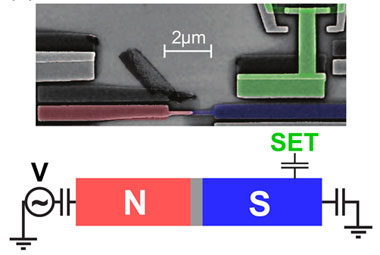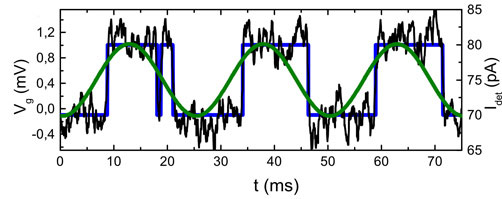| Aug 18, 2013 |
Growth of disorder of electrons measured in dual temperature system
|
|
(Nanowerk News) Researchers at Aalto University and the University of Tokyo have succeeded for the first time in experimentally measuring a probability distribution for entropy production of electrons.
|
|
Entropy production means an increase in disorder when electrons are moved individually between two microscopic conductors of differing temperatures.
|
|
The researchers also showed that a connection prevails between two definitions of entropy that have been used. The result is significant for the design of future nanoelectronic devices. The study was published recently in the scientific journal Nature Physics ("Distribution of entropy production in a single-electron box").
|
 |
| The diagram of a measured sample. It includes two microscopic conductors (N and S); individual electrons can move between them. The electrons are controlled by an external voltage V_g, and the number of electrons in the conductor S can be read with the help of a single-electron transistor (SET). Here is an electron microscope image with the parts corresponding to the diagram coloured in.
|
|
Similar experiments have been conducted before, but this is the first time that researchers have used conductors at different temperatures to measure the entropy production of electrons.
|
|
‘Entropy production is defined either by the time when the shift takes place or by the heat that moves from one conductor to another. In the study we measured electronic entropy production according to both definitions. The change in entropy in an individual measurement is random: the distribution for production is acquired by repeating the process about 100,000 times, for instance. Both distributions follow the so-called fluctuation relation’, says doctoral student Jonne Koski.
|
 |
| An example of a measurement. Changing the voltage (green line) causes electrons to move between the conductors. Electron transfers are seen as changes in the detector's signal (black line).
|
|
Fluctuation relations are relatively new discoveries of thermodynamics and statistical physics. When the probability to produce a certain amount of disorder of electrons, or entropy, is precisely known, the fluctuation relation is an equation, which gives a probability for the decrease in the amount of entropy. Therefore, the degree of disorder of electrons can decline when the nanostructures are examined for short periods of time.
|
|
‘Entropy production leads to overheating in the nanostructures, which is why it is important to get more information on their heat transmission properties’, observes Professor Jukka Pekola.
|


